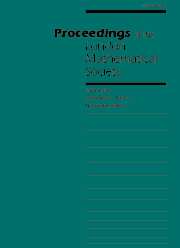Article contents
SUR LES LOIS LOCALES DE LA RÉPARTITION DU k-IÈME DIVISEUR D'UN ENTIER
Published online by Cambridge University Press: 06 March 2002
Abstract
Let $\{d_j(n)\}_{j=1}^{\tau(n)}$ denote the increasing sequence of divisors of an integer $n$, and write $\Lambda_k(d)$ for the natural density of the set of those integers $n$ with $d_k(n)=d$. Answering a question raised by Erd\H os, we show that $\Lambda_k(d)$ attains its maximum for $d=K^{1/2+o(1)}$, where $K:=k^{(\log \log k)/\log 2}$ (which, by a theorem of Ramanujan, is roughly the size of the smallest integer having $k$ divisors). A key step of the proof consists in establishing a sublinearity property of the counting function $\Psi_1(x,y)$ of $y$-friable square-free integers not exceeding $x$. This is achieved via a complete study of $\Psi_1(x,y)$ using the saddle-point method, which, in particular, also enables a precise description of the Gaussian behaviour of this function in certain ranges.
2000 Mathematical Subject Classification: 11N25, 11N37.
Keywords
- Type
- Research Article
- Information
- Copyright
- 2002 London Mathematical Society
- 8
- Cited by


